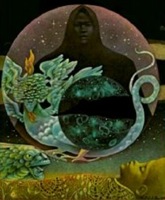Kything
Origin
Middle English, from Old English cȳthan, from cūth
Definitions
- 1: to make known
Description
Kything is from an old Scottish word, "kythe," meaning "to make visible." Madeleine L'Engle used it to describe a fictional type of communication, in a sense like telepathy, found in several of the books in her Time Quartet. L'Engle reportedly discovered the term in "an old Scottish dictionary" belonging to her grandfather.
Kything in the Time books is a sort of wordless, mind to mind communication in which one person, in essence, almost becomes another, seeing through their eyes and feeling through their senses.
In such a frame of mind, the two people intuitively know the meaning of what the other is telling them, disregarding such things as words or pictures. The idea may be based on the concept of Oneness, which states that all that exists, is one in its source and end. Apparently, recollection and assertion of that concept puts a person "in Kythe" with that which they are concentrating on.
Kything is portrayed as a way to be present with others without regard to space, time, or relative size. Through kything, humans can be together inside a subcellular mitochondrion, as seen in A Wind in the Door, or in communication despite being centuries apart, as seen in A Swiftly Tilting Planet.
Characters depicted as kything include Charles Wallace Murry (for whom it comes naturally), Meg Murry and Calvin O'Keefe. Meg and Calvin share a particular bond with each other, part of their growing relationship which eventually leads to marriage. Meg also spends much of A Swiftly Tilting Planet kything with her brother, Charles Wallace, thus experiencing vicariously his travels in time while supporting his efforts with research and prayer.
